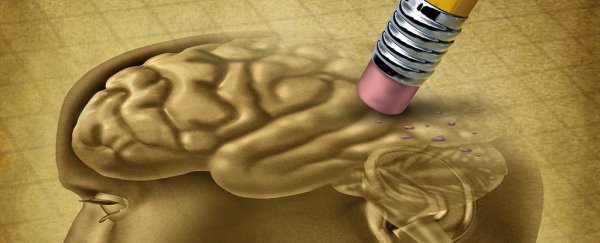An enzyme that interferes with key memory-forming processes in people with Alzheimer's can now be specifically targeted thanks to the discovery of a protein that helps it do its dirty work, according to new research out of MIT.
This crucial finding is getting us one step closer to a new kind of treatment that could one day prevent and even reverse memory loss in people with Alzheimer's.
Alzheimer's disease is a neurological condition associated with the build-up of beta-amyloid and tau proteins in the brain's cells.
Most cutting edge treatments have focussed on analysing and reducing the formation of these protein plaques to help the brain regain its functioning.
The exact role that these clumps play in giving rise to the symptoms of dementia in Alzheimer's patients has never been clear, and drugs that help clear out the clumps also don't seem to do much to return cognitive abilities.
MIT researcher Li-Huei Tsai and her colleagues believe something else must also be responsible, something that switches off the genes involved in for memory formation. For over a decade Tsai and her team have sought to understand the processes behind this genetic block.
"We think that once this epigenetic blockade of gene expression is in place, clearing beta amyloid may not be sufficient to restore the active configuration of the chromatin," Tsui said back in 2012.
A family of enzymes called histone deacetylases (HDAC) was suspected to be responsible, with earlier research showing it was possible to help transgenic mice recall tasks if those enzymes were blocked.
One enzyme in particular called HDAC2 was found to be overexpressed in the brains of people with Alzheimer's disease, giving researchers a target for treatment.
The enzyme acts as a master switch for the functioning of genes required in memory formation. In simple terms, HDAC2 causes protein called histones to wind DNA so tightly its code can no longer be transcribed.
For years researchers have tried to find ways to interfere with HDAC2's functioning, to no avail.
While there have been promising compounds that do the job, none have been specific enough to this target enzyme, inhibiting other members of the HDAC family and causing problems.
In this latest study, the team has identified a protein called Sp3 as a kind of partner in crime that helps HDAC2 do its dirty work.
"This is exciting because for the first time we have found a specific mechanism by which HDAC2 regulates synaptic gene expression," says Tsai.
To discover the diabolical pairing, the researchers looked at the expression of genes in postmortem brain samples taken from people who hadn't been diagnosed with Alzheimer's.
The samples were a mixed bag of high and low HDAC2 levels, allowing them to find candidate genes that seemed to work alongside the enzyme.
They then used an experimental technique called gene knockdown to prevent the expression of HDAC2 and other genes in mice, narrowing down their search to a gene that made the protein Sp3.
To check their work, the researchers used fragments of HDAC2 to connect with Sp3 in the mice, effectively mopping up the proteins and preventing them from forming a complex with complete HDAC2 enzymes.
The clean-up helped restore function in the mice's nerves, providing evidence of the fact that the enzyme and its helper were both required to latch onto the histones and DNA and prevent them from working.
Making HDAC2 fragments might have worked for the transgenic mice, but doesn't offer any direct hope of a treatment in humans.
But that's not to say a similar pharmaceutical couldn't do the same job.
"This therapeutic approach is specific to the action of HDAC2 and does not affect other HDACs, such as the close homologue HDAC1," says Andre Fischer from the German Center for Neurodegenerative Diseases, who was not involved in the study.
"The data raise hopes that therapeutic strategies targeting Sp3 or the interaction of Sp3 with HDAC2 may overcome the issue of lacking specificity of HDAC2 inhibitors."
Alzheimer's disease is the most common form of dementia, responsible for taking the lives of an increasing number of people each year.
Identifying such a key chemical partnership gives us hope that a new drug targeting it will one day help turn the tide on the devastating condition.
This research was published in Cell Reports.
